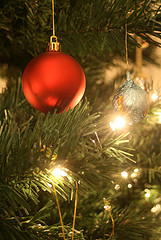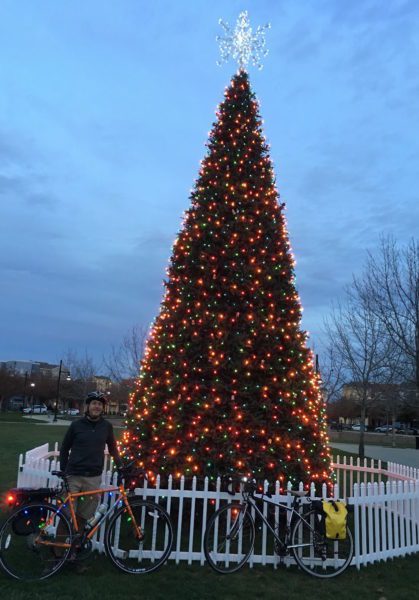We harvest trees for various practical purposes – lumber, furniture, paper, writing utensils, boats, signs, musical instruments, crates, boxes, cellophane, adhesive, and more. Most trees are harvested for valuable and long-lasting purposes, while the Christmas Tree has no purpose other than to act as a fleeting ornament.

This time of year, millions of Balsam, Douglas, and Fraser Fir trees are chopped from the earth, exchanged for pulp dollar bills, and hauled home. The cut tree is carefully positioned indoors and embellished with lights, ornaments, and ribbon, marking the once-living tree an adored “Christmas Tree.” After a brief 3 – 4 weeks of serving as an indoor art piece, it is returned to the earth as mulch.
Even though holiday trees are grown for disposal, the wastefulness of killing a tree for a few weeks of decoration is odd. Shouldn’t trees should remain alive in their own right?
How Christmas Trees Are Grown
Millions of fir trees are grown in Oregon, North Carolina, and Michigan farmlands to support the Christmas tree tradition. About 80% of U.S.-purchased trees come from the Willamette Valley in Oregon. The farms are planted and replenished with trees each year for this purpose. Like any other mono-crop, the trees are planted in repeated linear rows on massive lots and grown until they are ready to be harvested (about 5 – 7 years for a 6’ tall tree). Growing the trees requires harmful chemicals, including herbicides, pesticides, fungicides, or accelerated growth sprays. Hence, like food, purchasing an organically farmed tree is an alternative option to encourage farmers to adopt more environmentally responsible practices.
Why the Tradition Continues

Decorating a freshly cut evergreen tree helps some people feel a connection to nature while cooped up indoors. The pleasant aroma may remind some of a forest. Many families have joyous memories of choosing a tree and bringing it home. Decorating can conjure up memories of the festive tradition while the glow of the blinking lights and glitter provide radiance on a cold and dark winter day.
Artificial or Real?
There are benefits to both. Tree farms can benefit us by cleaning the air we breathe. The farms offer beautiful green views in the summer, cool the nearby air, provide revenue for local farmers, and overall support for the US economy. On the other hand, artificial trees can be reused for years and don’t require an annual trip to hunt and haul them away.
Christmas Tree Alternatives To Consider:
1. Decorate an Outdoor Tree. Decorate a tree in or near your yard and get outside daily to enjoy the view. Even better: hang some edible decorations for the birds, using fruits such as orange halves or suet cakes. You will enjoy watching the wildlife nibble away at your garland, and they will enjoy having fresh snacks in winter.
2. Plant a Live Indoor Tree. Plant and grow a tree inside the house and decorate it each season. Or, buy a live balled-and-burlapped evergreen tree that can be replanted in your backyard as a landscape tree after Christmas. This is an excellent option if you live in a climate with a mild winter, such as here in the Southeast, where you can replant the tree from late December to early January. Living Christmas trees can often be purchased at retail lots, tree farms, and garden centers. Tips for planting a live Christmas tree.
3. Rent a Live Potted Tree. Have a live tree delivered to your doorstep and picked up after the holidays. Check the Christmas Tree locator website to find out if a local tree farm or nursery provides this service.
4. Decorate an Artificial Plastic Tree. Compared to a cut tree, the advantages of an artificial tree are that it is convenient, reusable, cheaper over the long term, and produces less mess. Disadvantages of fake trees:
- It is a fake plastic tree so that it can look tacky;
- Most plastic trees are made of PVC (polyvinyl chloride), a petroleum-based plastic that releases cancer-causing dioxins into the environment during its manufacturing process;
- Plastic trees may contain other toxic chemicals such as lead;
- Requires storage space when not in use;
- Provides little support to the US economy – 80% are made in China (according to the US Commerce Department);
- PVC does not biodegrade and can not be recycled, so it will eventually end up in a landfill.
5. Make An Artificial Tree. Get creative decorating a tree. The tree shown here uses a PVC pipe for the base construction markers for the branches and 400 collected Mountain Dew cans for the leaves. If you think a plastic tree looks tacky — try this one! At least it is made with recyclable materials! Instructions for building a tree from mountain dew cans.

6. Do Nothing. Skip the Christmas tree decorating tradition. Instead, go to someone else’s house and admire their tree or to a city park with a decorated tree (your taxes paid for it). Better yet, walk in a forest and gaze at the living ones.
And no matter what you decide to do, remember to recycle! Recycling is the most effective way to save a tree. If you choose to light up a tree, use LED lights. They use 1/10 the electricity of a standard bulb.
Are you uncomfortable with purchasing a cut tree? How do you approach this tradition for the holiday?
Related Posts: